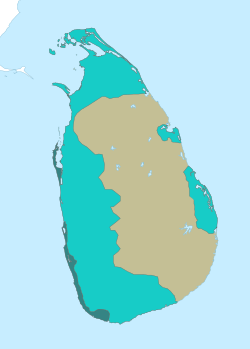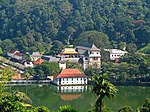
Back Colònia portuguesa de Ceilan Catalan Ceilán portugués Spanish Ceylan portugais French Ceylon Portugal ID ポルトガル領セイロン Japanese Ceilão português Portuguese Португальский Цейлон Russian පෘතුගීසි ලංකාව Singhalese Portuguese Ceylon SIMPLE போர்த்துக்கேய இலங்கை Tamil
Portuguese Ceylon Ceilão Português (Portuguese) පෘතුගීසි ලංකාව (Sinhala) pṛtugīsi laṁkāva போர்த்துக்கேய இலங்கை (Tamil) Pōrttukkēya ilaṅkai | |||||||||||||
|---|---|---|---|---|---|---|---|---|---|---|---|---|---|
| 1597[1]–1658 | |||||||||||||
 After the death of King Dharmapala (1597) Portuguese Ceylon at its greatest extent 1594–1619 | |||||||||||||
| Status | Colony of Portugal | ||||||||||||
| Capital | Colombo | ||||||||||||
| Common languages | Portuguese (official) Sinhala Tamil | ||||||||||||
| Religion | Roman Catholicism | ||||||||||||
| King of Portugal | |||||||||||||
• 1597–1598 | Philip I | ||||||||||||
• 1598–1621 | Philip II | ||||||||||||
• 1621–1640 | Philip III | ||||||||||||
• 1640–1656 | John IV | ||||||||||||
• 1656–1658 | Afonso VI | ||||||||||||
| Captain-General | |||||||||||||
• 1597–1614 | Jerónimo de Azevedo | ||||||||||||
• 1656–1658 | António de Amaral de Meneses | ||||||||||||
| Historical era | Colonialism | ||||||||||||
• Portuguese arrival | 1505 | ||||||||||||
• Death of Dharmapala of Kotte | 27 May 1597[1] | ||||||||||||
• Luso–Kandyan Treaty | 1633 | ||||||||||||
• Surrender of Jaffna | June 1658 | ||||||||||||
| |||||||||||||
Portuguese Ceylon (Portuguese: Ceilão Português; Sinhala: පෘතුගීසි ලංකාව; Tamil: போர்த்துக்கேய இலங்கை) is the name given to the territory on Ceylon, modern-day Sri Lanka, controlled by the Portuguese Empire between 1597 and 1658.
Portuguese presence in the island lasted from 1505 to 1658. Their arrival was largely accidental, and the Portuguese sought control of commerce, rather than territory. The Portuguese were later drawn into the internal politics of the island with the political upheaval of the Wijayaba Kollaya, and used these internal divisions to their advantage during the Sinhalese–Portuguese War, first in an attempt to control the production of valuable cinnamon and later of the entire island. Direct Portuguese rule did not begin until after the death of Dharmapala of Kotte, who died without an heir, and had bequeathed the Kingdom of Kotte to the Portuguese monarch in 1580.[2] That allowed the Portuguese sufficient claim to the Kingdom of Kotte upon Dharmapala's death in 1597. Portuguese rule began with much resistance by the local population.[3]
Eventually, the Kingdom of Kandy sought help from the Dutch East India Company, with whom they initially entered into agreement. After the collapse of the Iberian economy in 1627, the Dutch–Portuguese War saw the Dutch conquest of most of Portugal's Asian colonies – Ceylon included, between 1638 and 1658. Nevertheless, elements of Portuguese culture from this colonial period remain in Sri Lanka.
| History of Kandy |
|---|
 |
| Kingdom of Kandy (1469–1815) |
| Colonial Kandy (1815–1948) |
| Kandy (1948–present) |
| See also |
|
|
- ^ Ceylon and the Portuguese, 1505–1658 (1920). Author: Pieris, P. E. (Paulus Edward), 1874–; Naish, Richard Bryant, 1891– Subject: Sri Lanka – History p.140
- ^ De Silva (1981), p. 114
- ^ De Silva (1981), p. 100

